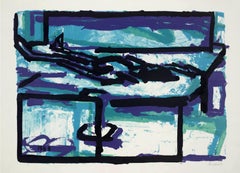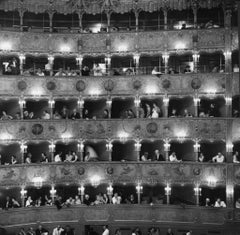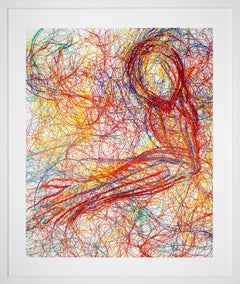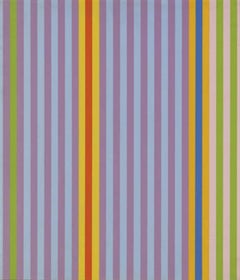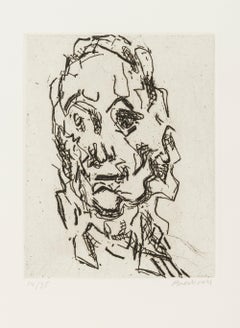Frank Auerbach Art
British, b. 1931
Frank Auerbach is one of Britain’s pre-eminent postwar artists. His subject matter is rooted in his north London surroundings or people he knows well – painting and drawing them over and over again. His oils, drawings, and prints reveal an intense observation of the subject; he makes his mark with authority and finality, to arrive at the essence of his subject. Auerbach’s signature thick black lines and the furious mark-making he employs, give his work an energetic quality. He holds a deep reverence for the ‘magic’ of printmaking, particularly etching and dry point, to reveal the essential qualities he seeks to express. He has completed, however, fewer than 40 editions throughout his career but increasingly working on a larger scale on a par with painting. For weeks and sometimes years, he observes and portrays the same people from among his circle of acquaintances who are asked to sit for him at regular times and days of the week, so that he can draw and paint them obsessively, over and over again, giving them rigorous attention.
His work is an expression of his very personal vision and experience by means of repetition and limitation, to concentrate the search for insight: into another person, into the self and into the world. His personal story is telling. He was born in Berlin in 1931 but sent to a boarding school for Jewish refugee children in Kent in 1939. His parents, who remained in Germany, died in concentration camps. He studied at St Martin’s School of Art, from 1948 to 1952, and met David Bomberg in night classes at Borough Polytechnic and developed a friendship with fellow student Leon Kossoff. He then went on to study at the Royal College of Art from 1952 to 1955. Auerbach exhibited regularly at the Beaux-Arts Gallery until 1963. From 1965 he exhibited at the Marlborough Gallery and was given an Arts Council retrospective at the Hayward Gallery, London in 1978, and had solo exhibitions at the British Pavilion in the 1986 Venice Biennale, and at the Rijksmuseum Vincent Van Gogh, Amsterdam, 1989. Rarely leaving England (he is now in his 80’s), he has had the same studio since the 1950s.
Auerbach’s work can be found in public collections worldwide including the British Museum, London, England; Cleveland Museum of Art, Cleveland, Ohio; Frissiras Museum of Contemporary Art, Athens, Greece; Israel Museum, Jerusalem, Israel; The Metropolitan Museum of Art, New York; Museo de Arte Moderna da Bahia, Salvador, Brazil; Museo Rufino Tamayo, Mexico City, Mexico; Museum of Modern Art, New York; National Gallery of South Africa, Cape Town, South Africa; Royal College of Art, London, England; Scottish National Gallery of Modern Art, Edinburgh, Scotland; Tate Britain, London, England.(Biography provided by Joanna Bryant Projects)
to
2
1
2
1
1
1
1
1
2
Overall Height
to
Overall Width
to
2
1
1
1
1
1
3
1
1
1
3
6,886
3,210
2,514
1,217
1
1
1
1
Artist: Frank Auerbach
Reclining Figure 1
By Frank Auerbach
Located in Rancho Santa Fe, CA
22 5/8 x 31 7/8 (image size)
27 1/4 x 39 3/8 (sheet size/sight size)
Color screenprint
Edition 8 of 70
Numbered lower left: "8/70"
Signed lower right: "Auerbach"
This item is in our...
Category
1960s Abstract Frank Auerbach Art
Materials
Screen
'La Fenice' Venice Opera House Giant Silver Gelatin Print
By Frank Auerbach
Located in London, GB
'La Fenice' by Erich Auerbach
A general view of the boxes at La Fenice, the Venice Opera House, 1st January 1954.
A beautiful silver gelatin fibre pr...
Category
1950s Modern Frank Auerbach Art
Materials
Silver Gelatin
Head of JYM III - 20th Century, Chalk and charcoal on paper by Frank Auerbach
By Frank Auerbach
Located in London, GB
Chalk and charcoal on paper.
Auerbach met Juliet Yardley Mills in 1956, when she was working as a model at Sidcup College of Art. He began to paint her the following year, and contin...
Category
1980s Modern Frank Auerbach Art
Materials
Chalk, Charcoal
Related Items
"The Color of Mind and Muscle" by James Rosenquist
By James Rosenquist
Located in Hinsdale, IL
James Rosenquist
(1933-2017)
"Color of Mind and Muscle"
Screenprint in colors on wove paper, 1996
31-1/2 x 25-3/4 inches (80 x 65.4 cm) (sheet)
A.P. 7/10 edition of 30
Signed, numb...
Category
1990s Abstract Expressionist Frank Auerbach Art
Materials
Screen
Series 2
By Gene Davis
Located in Irvine, CA
This is a bright color screenprint on canvas laid on board by American artist Gene Davis (1920-1985). It is titled "Series 2", measures 30" x 24" and completed in 1969. It is beautif...
Category
1960s Abstract Frank Auerbach Art
Materials
Canvas, Board, Screen
untitled (orange)
By Richard Hunt
Located in New York, NY
Untitled (orange) 1980 screenprint by Richard Hunt measuring 22 by 30 inches. This example is designated 41 from an edition of 80. The work is professionally matted.
Category
1980s Abstract Frank Auerbach Art
Materials
Screen
Rare Modernist Hungarian Rabbi Pastel Drawing Gouache Painting Judaica Art Deco
By Hugó Scheiber
Located in Surfside, FL
Rabbi in the synagogue at prayer wearing tallit and tefillin.
Hugó Scheiber (born 29 September 1873 in Budapest – died there 7 March 1950) was a Hungarian modernist painter.
Hugo Scheiber was brought from Budapest to Vienna at the age of eight where his father worked as a sign painter for the Prater Theater. At fifteen, he returned with his family to Budapest and began working during the day to help support them and attending painting classes at the School of Design in the evening, where Henrik Papp was one of his teachers. He completed his studies in 1900. His work was at first in a post-Impressionistic style but from 1910 onward showed his increasing interest in German Expressionism and Futurism. This made it of little interest to the conservative Hungarian art establishment.
However, in 1915 he met the great Italian avant-gardist Filippo Tommaso Marinetti and the two painters became close friends. Marinetti invited him to join the Futurist Movement. The uniquely modernist style that he developed was, however, closer to German Expressionism than to Futurism and eventually drifted toward an international art deco manner similar to Erté's. In 1919, he and his friend Béla Kádar held an exhibition at the Hevesy Salon in Vienna. It was a great success and at last caused the Budapest Art Museum to acquire some of Scheiber's drawings. Encouraged, Scheiber came back to live in Vienna in 1920.
A turning point in Scheiber's career came a year later, when Herwarth Walden, founder of Germany's leading avant-garde periodical, Der Sturm, and of the Sturm Gallery in Berlin, became interested in Scheiber's work. Scheiber moved to Berlin in 1922, and his paintings soon appeared regularly in Walden's magazine and elsewhere. Exhibitions of his work followed in London, Rome, La Paz, and New York.
Scheiber's move to Germany coincided with a significant exodus of Hungarian artists to Berlin, including Laszlo Moholy-Nagy and Sandor Bortnyik. There had been a major split in ideology among the Hungarian avant-garde. The Constructivist and leader of the Hungarian avantgarde, Lajos Kassák (painted by Hugó Scheiber in 1930) believed that art should relate to all the needs of contemporary humankind. Thus he refused to compromise the purity of his style to reflect the demands of either the ruling class or socialists and communists. The other camp believed that an artist should be a figurehead for social and political change.
The fall out and factions that resulted from this politicisation resulted in most of the Hungarian avant gardists leaving Vienna for Berlin. Hungarian émigrés made up one of the largest minority groups in the German capital and the influx of their painters had a significant effect on Hungarian and international art. Another turning point of Scheiber's career came in 1926, with the New York exhibition of the Société Anonyme, organized by Katherine Dreier. Scheiber and other important avant garde artists from more than twenty-three countries were represented. In 1933, Scheiber was invited by Marinetti to participate in the great meeting of the Futurists held in Rome in late April 1933, Mostra Nazionale d’Arte Futurista where he was received with great enthusiasm. Gradually, the Hungarian artists began to return home, particularly with the rise of Nazism in Germany. Kádar went back from Berlin in about 1932 and Scheiber followed in 1934.
He was then at the peak of his powers and had a special flair in depicting café and cabaret life in vivid colors, sturdily abstracted forms and spontaneous brush strokes. Scheiber depicted cosmopolitan modern life using stylized shapes and expressive colors. His preferred subjects were cabaret and street scenes, jazz musicians, flappers, and a series of self-portraits (usually with a cigar). his principal media being gouache and oil. He was a member of the prestigious New Society of Artists (KUT—Képzőművészek Új Társasága)and seems to have weathered Hungary's post–World War II transition to state-communism without difficulty. He continued to be well regarded, eventually even receiving the posthumous honor of having one of his images used for a Russian Soviet postage stamp (see image above). Hugó Scheiber died in Budapest in 1950.
Paintings by Hugó Scheiber form part of permanent museum collections in Budapest (Hungarian National Museum), Pecs (Jannus Pannonius Museum), Vienna, New York, Bern and elsewhere. His work has also been shown in many important exhibitions, including:
"The Nell Walden Collection," Kunsthaus Zürich (1945)
"Collection of the Société Anonyme," Yale University Art Gallery, New Haven, Connecticut (1950)
"Hugó Scheiber: A Commemorative Exhibition," Hungarian National Museum, Budapest (1964)
"Ungarische Avantgarde," Galleria del Levante, Munich (1971)
"Paris-Berlin 1900-1930," Centre Georges Pompidou, Paris (1978)
"L’Art en Hongrie, 1905-1920," Musée d’Art et l’Industrie, Saint-Etienne (1980)
"Ungarische Avantgarde in der Weimarer Republik," Marburg (1986)
"Modernizmus," Eresz & Maklary Gallery, Budapest (2006)
"Hugó Scheiber & Béla Kádár," Galerie le Minotaure, Paris and Tel Aviv (2007)
Hugó Scheiber's paintings continue to be regularly sold at Sotheby's, Christie's, Gillen's Arts (London), Papillon Gallery (Los Angeles) and other auction houses.
He was included in the exhibition The Art Of Modern Hungary 1931 and other exhibitions along with Vilmos Novak Aba, Count Julius Batthyany, Pal Bor, Bela Buky, Denes Csanky, Istvan Csok, Bela Czobel, Peter Di Gabor, Bela Ivanyi Grunwald, Baron Ferenc Hatvany, Lipot Herman, Odon Marffy, C. Pal Molnar...
Category
Early 20th Century Modern Frank Auerbach Art
Materials
Paper, Charcoal, Pastel, Watercolor, Gouache
Concentration
By Harvey Daniels
Located in Llanbrynmair, GB
’Concentration’
By Harvey Daniels
Medium - Screen print
Signed - Yes
Edition - 16/30
Size - 890mm x 670mm
Condition - 10
Colour of print may not be accurate when viewed on a monitor...
Category
Late 20th Century Abstract Frank Auerbach Art
Materials
Screen
Architectural Gelatin SIlver Print Vellum Photograph Mark Citret Vintage Photo
By Mark Citret
Located in Surfside, FL
Mark Citret, American, b. 1949.
"Third Story Arches", Fort Point, 1998
Silver gelatin print hand signed and editioned 1/45 in pencil along lower edge.
Published: "Along the Way" Mark...
Category
1990s American Modern Frank Auerbach Art
Materials
Vellum, Silver Gelatin
Untitled, from ‘The International Association of Art Portfolio’
By Max Bill
Located in Llanbrynmair, GB
Untitled, from ‘The International Association of Art Portfolio’
By Max Bill
Medium - Screen print
Edition - 3/25
Signed - Yes
Size - 640mm x 460mm
Date...
Category
Mid-20th Century Abstract Frank Auerbach Art
Materials
Screen
Madonna and Child - Colored Chalk Drawing - 19th Century
Located in Roma, IT
Madonna and Child is a beautiful colored chalk low relief realized in the 19th Century by Anonymous Artist.
Frame included: 96x70 cm.
Good condition except some minor cracks and lo...
Category
19th Century Modern Frank Auerbach Art
Materials
Chalk, Paper
H 32.68 in W 22.25 in D 1.97 in
1940s Charcoal and Pencil Portrait of a Man
Located in Arp, TX
Artist Unknown
"Tie and Glasses"
c. 1940s
Charcoal and pencil on paper
13.5"x17" image 15.5"x19" paper unframed $250
Unsigned
*Listed price reflects custom framing selected by seller...
Category
1940s Modern Frank Auerbach Art
Materials
Paper, Charcoal, Carbon Pencil
Lincoln Center's Mostly Mozart Festival - 25th Anniversary
By Robert Motherwell
Located in Aramits, Nouvelle-Aquitaine
Robert Motherwell, American (1915 - 1991)
Lincoln Center's Mostly Mozart Festival, 25th Anniversary.
Lithograph, Edition of 800, unsigned and unnumber...
Category
1990s Abstract Expressionist Frank Auerbach Art
Materials
Lithograph, Screen
H 42.38 in W 31.63 in D 0.6 in
HUMAN ATMOSPHERE Retro-study 5 - contemporary artwork, emerging artist
By Michael Pemberton
Located in London, GB
In this exhibition, British painter Michael Pemberton (b. 1974) suggests we each have a personal HUMAN ATMOSPHERE. An ether where we truly exist, unseen by the naked eye but as real ...
Category
21st Century and Contemporary Abstract Frank Auerbach Art
Materials
Chalk, Charcoal
H 30 in W 19 in D 1.5 in
Eyes, Chicago by György Kepes, 1940, Silver Gelatin Print, Photography
By György Kepes
Located in Dallas, TX
Untitled #42 (Eyes, Chicago), by György Kepes is a 4 1/2 x 3 5/8 inch gelatin silver print mounted on 16 1/4 x 13 1/4 inch paper. This photograph is signed and dated in pencil on mou...
Category
Mid-20th Century Modern Frank Auerbach Art
Materials
Silver Gelatin
H 4.5 in W 3.63 in D 0.1 in
Previously Available Items
Ruth -- Print, Etching, Portrait, Contemporary Art by Frank Auerbach
By Frank Auerbach
Located in London, GB
FRANK AUERBACH
Ruth, 2001-2
Etching printed with tone, on Somerset white paper
Signed and numbered from the edition of 35
Printed by Mark Balakjian and...
Category
Early 2000s Contemporary Frank Auerbach Art
Materials
Etching
Ruth -- Print, Etching, Portrait, Contemporary Art by Frank Auerbach
By Frank Auerbach
Located in London, GB
FRANK AUERBACH
Ruth, 2001-2
Etching printed with tone, on Somerset white paper
Signed and numbered from the edition of 35
Printed by Mark Balakjian and...
Category
Early 2000s Contemporary Frank Auerbach Art
Materials
Etching
Ruth II
By Frank Auerbach
Located in New York, NY
Frank Auerbach, Ruth II, 1994
One of Britain's preeminent postwar painters, Frank Auerbach, was born in Berlin, Germany in 1931. Arriving in England ...
Category
1990s Frank Auerbach Art
Frank Auerbach art for sale on 1stDibs.
Find a wide variety of authentic Frank Auerbach art available for sale on 1stDibs. You can also browse by medium to find art by Frank Auerbach in screen print and more. Much of the original work by this artist or collective was created during the 1960s and is mostly associated with the abstract style. Not every interior allows for large Frank Auerbach art, so small editions measuring 40 inches across are available. Customers who are interested in this artist might also find the work of Stanley William Hayter, Gordon House, and Victor Pasmore. Frank Auerbach art prices can differ depending upon medium, time period and other attributes. On 1stDibs, the price for these items starts at $3,500 and tops out at $3,500, while the average work can sell for $3,500.
Artists Similar to Frank Auerbach
Questions About Frank Auerbach Art
- What is Frank Auerbach style?1 Answer1stDibs ExpertApril 5, 2022Frank Auerbach is a figure painter whose work has been described as expressionist, however, he more accurately fits into the neo-expressionist classification. He’s also been known for creating semi-abstract portraits, which puts him more accurately in the modern art movement. On 1stDibs, find a variety of original artwork from top artists.
